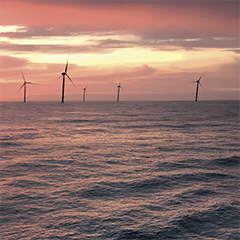Old layout, new layout – the same geotechnical campaign?
‘Measure twice, cut once’ as the old proverb goes. And it is true. A thorough geological site investigation campaign is one of the most important sources of data when it comes to designing foundations. Especially in the case of high-risk offshore constructions such as wind turbines. However, what should we do if the style changes even before we start to cut? Or, even worse, climate change forces us to sew a summer dress instead of making a winter coat? Should we measure once again? Moreover, what if the client is far away and does not want to be bothered? Can we deduce the missing values for the new dress pattern from existing measurements?
All of these questions arise if the layout of a wind farm changes after the geotechnical campaign has been completed. It may take several years to develop an offshore wind farm project from the initial desk studies through to the construction phase. During this time, a number of reasons may lead to changes to the original wind farm layout, the position of the wind turbines in relation to each other. One of them is the continuing development of wind turbine technology itself and the availability of ever larger and ever more efficient turbine generations during the planning phase. Another reason results from the geophysical and geotechnical campaign itself. Some locations, although theoretically leading to a high wind yield, may incur high foundation costs due to their geological settings: e.g., glacial channels filled with soft sediments.
However, changes to the turbine layout usually have to be approved by the corresponding authority. The requirements of the different national regulatory authorities can vary greatly. For example, German authorities normally require a borehole or a cone penetration test at every planned wind turbine location to prove and confirm the proposed foundation design. Consequently, if changes are made to the layout during the project planning phase, a new geotechnical campaign is generally needed. In certain cases, however, regulatory authorities will accept an estimation of the soil properties at unexplored locations based on available data. Nevertheless, the project, including the layout changes and the foundation design, still has to be certified and officially approved.
How are the soil conditions at a geotechnically unexplored site estimated? The key words here are ‘synthetic cone penetration test’ and ‘intelligent ground model’. Intelligent ground models allow the extraction of geotechnical data at any point of the wind farm site based on the interpolation of geotechnical data supported by geophysical data. Thus, the building of intelligent ground models containing geotechnical parameters of interest is currently one of the most important interdisciplinary topics in the endeavor to optimize site characterization efforts for wind farm development. To construct such a model, the available seismic and geotechnical in situ measurements, sometimes also laboratory data, are passed through a sieve of interpolation techniques.
Old layout, new layout – the same geotechnical campaign?
‘Measure twice, cut once’ as the old proverb goes. And it is true. A thorough geological site investigation campaign is one of the most important sources of data when it comes to designing foundations. Especially in the case of high-risk offshore constructions such as wind turbines. However, what should we do if the style changes even before we start to cut? Or, even worse, climate change forces us to sew a summer dress instead of making a winter coat? Should we measure once again? Moreover, what if the client is far away and does not want to be bothered? Can we deduce the missing values for the new dress pattern from existing measurements?
All of these questions arise if the layout of a wind farm changes after the geotechnical campaign has been completed. It may take several years to develop an offshore wind farm project from the initial desk studies through to the construction phase. During this time, a number of reasons may lead to changes to the original wind farm layout, the position of the wind turbines in relation to each other. One of them is the continuing development of wind turbine technology itself and the availability of ever larger and ever more efficient turbine generations during the planning phase. Another reason results from the geophysical and geotechnical campaign itself. Some locations, although theoretically leading to a high wind yield, may incur high foundation costs due to their geological settings: e.g., glacial channels filled with soft sediments.
However, changes to the turbine layout usually have to be approved by the corresponding authority. The requirements of the different national regulatory authorities can vary greatly. For example, German authorities normally require a borehole or a cone penetration test at every planned wind turbine location to prove and confirm the proposed foundation design. Consequently, if changes are made to the layout during the project planning phase, a new geotechnical campaign is generally needed. In certain cases, however, regulatory authorities will accept an estimation of the soil properties at unexplored locations based on available data. Nevertheless, the project, including the layout changes and the foundation design, still has to be certified and officially approved.
How are the soil conditions at a geotechnically unexplored site estimated? The key words here are ‘synthetic cone penetration test’ and ‘intelligent ground model’. Intelligent ground models allow the extraction of geotechnical data at any point of the wind farm site based on the interpolation of geotechnical data supported by geophysical data. Thus, the building of intelligent ground models containing geotechnical parameters of interest is currently one of the most important interdisciplinary topics in the endeavor to optimize site characterization efforts for wind farm development. To construct such a model, the available seismic and geotechnical in situ measurements, sometimes also laboratory data, are passed through a sieve of interpolation techniques.
To read the full content,
please download the PDF below.



























